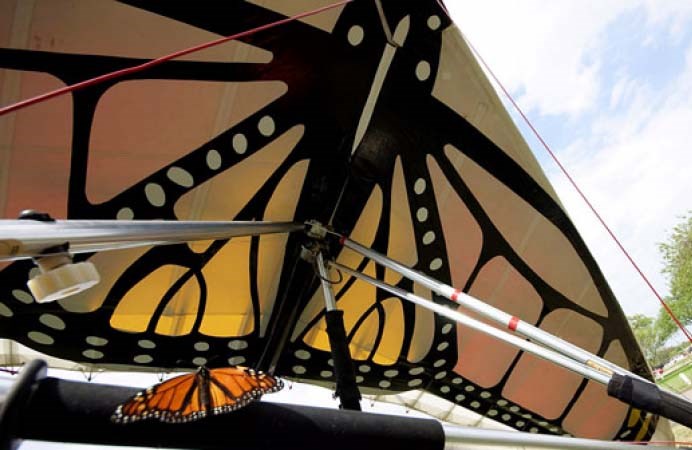In August 2005, Mexican filmmaker and pilot Francisco “Vico” Gutiérrez took off in an ultralight aircraft from Montreal to follow monarch butterflies on their 6,000 km migration route from Canada to Mexico.
The flight, which lasted 72 days, was designed to raise awareness on the importance of preserving the iconic orange-and-black insect’s habitat. Sadly, the monarch was placed on the international endangered species list in 2022.
Monarch butterflies tend to cluster along Canada’s east coast before flying south and zig-zagging to Texas before entering Mexico. Along the way, loss of forested habitats, chemical pesticides and climate change factor into their demise. Scientists have estimated that depending on measurements used, the numbers have declined from 22 per cent to 72 per cent in the last decade.
Gutiérrez’s flight, a collaboration between the Canadian Aviation and Space Museum and the Embassy of Mexico, produced an exhibition from recorded material while flying aboard the Papalotzin, a nickname for the ultralight aircraft he piloted.
Papalotzin means “small butterfly” in the Aztec language. On the Trail of the Monarch Butterfly is currently Gutiérrez’s panel exhibit at Musée Heritage Museum. Viewed through photographs and a 60-minute documentary video, this monumental journey is available for public viewing until June 18.
“We always like to bring in natural history exhibits. Mostly we do human history of St. Albert. But with spring on the horizon, we’ve been talking about pollinators – bees and butterflies – and what people can do to encourage pollinators,” said museum curator Joanne White.
Throughout the exhibit, Gutiérrez documents not only the monarch’s life cycle, but also the extreme challenges and various types of terrain it crosses from thundering waterfalls and grasslands to dry desert and bare mountain ranges before settling in central Mexico.
Once in Mexico, photographs show they migrate, cluster and hibernate in forests such as El Rosario Reserve or the Sacred Fir Forest where tree branches are barely visible under a thick coat of resting monarchs.
In addition to the travelling exhibit, museum staff have created a swarm of monarchs on a wall with stickers and built a feature showcase of local plants that provide food for pollinators.
“Learning about nature is hugely important, especially how we can apply this to school, our gardens and walks in the river valley,” White said. “They are incredibly beautiful creatures, but if we lose our pollinators, we lose food, and our ecosystem will be irreparably damaged.”
For a closer view of nature, the museum is bringing in larvae kits of painted lady butterflies, a paler version of the monarch that is indigenous to Alberta. Once kits arrive May 8, visitors are encouraged to visit and observe the various stages of metamorphosis. The butterflies will be released during the Children's International Festival of the Arts.
The museum also hosts a family event on April 22 filled with crafts, cookie decorating face and painting. Butterfly expert Camilla Leurini will give a special presentation. The free event takes place between 2 p.m. and 4 p.m. at St. Albert Place.




